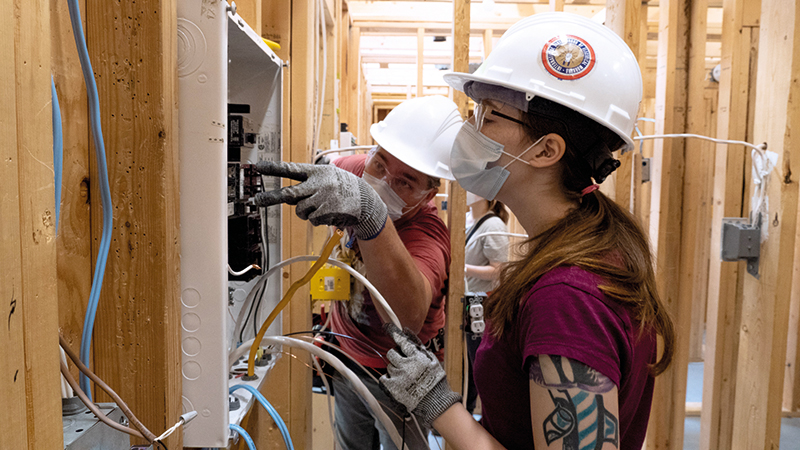Addressing the skilled labour shortage in the Canadian construction industry is a national pastime, with seemingly no shortage of attention paid by the federal government and their provincial counterparts. And with good reason.
This country’s labour force growth rate has been trending downward for nearly two decades and according to Statistics Canada, between 2016 and 2021 more than 1.4 million Canadians entered the ranks of those aged 55 and older.
A recent report from BuildForce Canada estimated the construction industry could be short as many as 29,000 workers by 2027. “An ongoing commitment to apprenticeship development in both compulsory and non-compulsory trades will be necessary to ensure there are sufficient numbers of qualified tradespeople to sustain a skilled labour force over the long term,” stated the report.
During the leadup to the most recent budget season, various levels of government announced plans to tackle the issue, including Prime Minister Justin Trudeau, who took the time during a recent town hall meeting to take questions from the members of the Carpenters’ District Council of Ontario at the union’s training centre.
Trudeau was asked about training, immigration and how to better promote careers in the skilled trades.
“I’m standing here in this training centre that is proof positive that you will continue to be able to adapt to all the new technologies, all the new opportunities that come in with the world that is transforming,” Trudeau told the audience. “Everyone says the future is going to be all digital and the future is going to be all science and technology. Absolutely, yes, and the jobs you are going to be doing are going to continue to get more sophisticated, require more and more technology and computers to do it, but building a house is never going to be done by a robot. The skills you have are always going to be necessary and they can’t be offshore.”
According to the Prime Minister, immigration policies are one way of addressing the shortage.
“One of the big questions we get all the time is as our government is raising immigration levels to the highest levels it’s ever been in a few years, we will be bringing in 500,000 people a year, we are already facing challenges in housing. Where are we going to house these 500,000 people?” Trudeau told the audience. “All these people would be able to contribute to the building trades a lot, particularly now that we are targeting changes in our immigration system that allow us to target more specifically areas where there are still shortages or trades shortages.”

Training facilities and apprenticeship programs to help bolster the ranks of construction workers have taken priority recently with millions in funding proposed.
In The Trades, a federally funded program that will help apprentices get started in the skilled trades was announced by Canada’s Building Trades Unions (CBTU). Over the next two years the program will provide financial incentives and training support for unionized small and medium-sized contractors that hire, train, and retain first-year apprentices to address labour availability across Canada.
“Canada’s Building Trades Unions are leaders in delivering the highest quality training to produce the safest, skilled trades workforce anywhere in the world. With the Building Trades vast network of training centres and employers; and world-class apprenticeship programs, we can ensure apprentices can access job opportunities, training, and support to not only start an apprenticeship but complete it,” said Sean Strickland, executive director, Canada’s Building Trades Unions. “With the support of the federal government, In The Trades will create opportunities for more Canadians from equity deserving groups to get started in an apprenticeship, while providing support to unionized contractors to grow Canada’s skilled trades workforce.”
Unionized employers can receive a grant of $5,000
for hiring a first-year apprentice, with an additional $5,000 available if the first-year apprentice is from an equity deserving group.
The goal is to secure 4,000 skilled trades positions with a focus on supporting candidates from equity deserving groups. CBTU has launched an online portal to streamline the application process for unionized employers and first-year apprentices to meet this goal. The program will run between September 2022 and March 2024 and CBTU will work with provincial and local building trades councils and affiliates across the country.
“The Building Trades of Alberta is dedicated to increasing diversity in the skilled trades and to fostering an inclusive work environment. This includes attracting and retaining more groups like women, Indigenous, new Canadians, youth, and apprentices to our unions through various outreach campaigns. Not only does this help bring in new talent and foster the next generation of skilled trades professionals, but it also helps fill the looming labour gap felt in our industry,” said Terry Parker, executive director, Building Trades of Alberta. “CBTU’s In The Trades will not only help these groups and others skill up, but it will also place them in rewarding careers in the unionized skilled trades, ones with pension, health and welfare benefits, and community and family-supporting wages.”
In Ontario, the provincial government announced $224 million to build and upgrade training centres, with an additional $75 million over the next three years earmarked to support the operations and programing at new and existing centres to prepare workers for in-demand careers like electricians, welders, and mechanics.
Applications for the new Skills Development Fund (SDF) capital stream are expected to open in late spring and will provide eligible applicants, including unions, Indigenous centres, businesses, and industry associations, with funding to build new training centres or to upgrade or convert their existing facilities into training centres with state-of-the-art design and technology. This includes facility renovations, retrofits, expansions, repairs and building construction.
“Ontario is facing the largest labour shortage in a generation, which means when you have a career in the skilled trades, you have a career for life,” said Monte McNaughton, Minister of Labour, Immigration, Training and Skills Development. “We’re supporting employers, unions and other training providers so that they can build and improve the facilities we need to attract and prepare our next generation of skilled trades workers for better jobs and bigger paycheques for themselves and their families.”
Training for indigenous communities, women, and underrepresented groups is also a focus across the country.
In British Columbia, the Electrical Joint Training Committee (EJTC) has had success with multiple First Nations cohorts currently moving through EJTC’s Red Seal electrician training pathway, emphasizing the success taking place in the classroom, in the field and the recruitment process.
“We want to have, along with the IBEW and our contractor group, an inclusive and diverse workforce that is robust and able to manage the ever-changing electrical world, but we have pretty rigorous pre-requirements to enter our program,” said managing director Phil Davis. “When we find bright, indigenous candidates with those pre-requisites, they’re also being recruited by 3000 other organizations, like the RCMP, for example.
“We asked, ‘How do we get indigenous workers into our system?’” added Davis. “Next, we designed an eight-week math and science prep program and said, ‘Come on in.’ We let our partners do the screening—the program sets these students up for success.”
Currently, the EJTC manages approximately 70 Indigenous apprentices and 900 apprentices overall. Indigenous students train at EJTC’s Port Coquitlam-based campus, as well as the Squamish Nation Training Centre.
“The growth of our Indigenous cohorts is a result of this very focused program we developed to make sure we’re bringing in the right candidates,” said Davis. “We’re upscaling their math and science so that we can put them on a path to an apprenticeship with us. Our Indigenous partners have been very glad to have that and strongly support this model…At their request, it’s an Indigenous-specific cohort.”
Davis and the EJTC currently feature an Indigenous roster of a dozen Foundation program students, two Level 2 cohorts and two Level 3 cohorts, the latter who will soon make the jump to their Level 4 training and inch that much closer to Red Seal certification. The continuing success and success stories are translating positively to EJTC’s initial barriers surrounding recruitment, explained Davis.
“We now have role models. Now, other students can look and say ‘I may not have thought I can do this’ before, but now we have people in a career that they’re thriving in.”
Construction companies themselves are also looking to help grow and diversify the trades. In Ontario, the Aecon Women in Trades (AWIT) program, helps women trade up and launch rewarding careers in the trades with fully paid training, and competitive wages and benefits.
The program is open to candidates with any employment background and no experience is required. Upon completing comprehensive training for in-demand skills, successful candidates are deployed in the field to hone their craft on a job site, benefiting from ongoing career development opportunities and mentoring.
“Women are disproportionately underrepresented in our industry. As we continue to see enhanced competition for talent, Aecon remains agile through challenging market and labour environments,” said Jenna Wood, senior director, HR for Aecon’s Utilities, Industrial and Nuclear sectors. “Our AWIT program is an illustration of this approach in action, and it has become a model of success in our industry while making Aecon’s team stronger through diversity.”
Launched in 2019, 75 participants have been trained to date, and the company is looking to expand that number to 350 in 2023.
Building Canada’s skilled trades workforce continues to be a work in progress, but with the attention it is receiving and the actions that are being taken, hopefully the shortage begins to shrink as the number of infrastructure projects continue to grow.
[This article originally appeared in the May/June 2023 edition of ReNew Canada]
With files from Angela Gismondi/Daily Commercial News
John Tenpenny is the editor of ReNew Canada.

Skilled Trade Scholarship Program
The Schulich Foundation announced Schulich Builders, a scholarship program dedicated to students pursuing a career in the skilled trades. In its first year of operation, more than $3 million is committed to combat labour shortages and highlight the importance of skilled trades in Canada.
“We are proud to promote the skilled trades and support students pursuing this rewarding career path,” said Judy Schulich, director, The Schulich Foundation. “Canadians rely heavily on the trades to build and maintain infrastructure critical for prosperous communities. Our challenge today is not having enough of these talented people to meet the demand.”
Schulich Builders will cover tuition, tools and living expenses for students enrolling in a skilled trade program at one of 10 participating colleges in Ontario. Priority will be given to students nominated by their high school. Students may also apply directly through participating colleges: Centennial, Fanshawe, Algonquin, George Brown, Mohawk, Sheridan, Conestoga, Durham, Humber and Loyalist.
“Ontario is facing the largest labour shortage in a generation, which means when you have a career in the skilled trades, you have a career for life,” said Monte McNaughton, Ontario’s Minister of Labour, Immigration, Training and Skills Development. “With Schulich Foundation’s skilled trade scholarship program, they are helping to attract and prepare a new generation of skilled trades workers here in Ontario for better jobs and bigger paycheques.”
Each college will award 10 scholarships per year:
- five $20,000 scholarships for one-year certificate programs, and
- five $40,000 scholarships for two-year diploma programs
In addition to financial support, Schulich Builders also provides leadership training and mentorship to set up graduates for success.
“Against the backdrop of the new Schulich Builders program, I am utterly delighted to witness the Schulich Foundation now partnering with Colleges to promote scholarship opportunities to prospective students seeking to pursue a post-secondary education that will lead to fulfilling, well-paying and in-demand jobs,” said Dr. Craig Stephenson, president and CEO, Centennial College.
Featured image: B.C.’s Electrical Joint Training (ETC) Committee manages approximately 70 Indigenous apprentices and 900 apprentices overall through its Red Seal electrician training pathway. (ETC)












